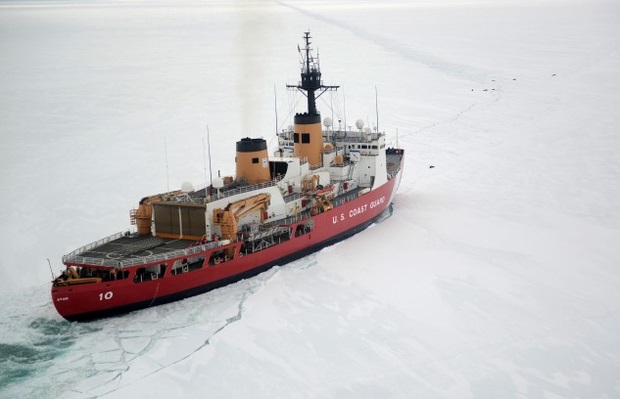Coast Guard Polar Icebreaker Mired in Fight Over Mexico Wall
- Senator seeks $750 million for `floating northern border’
- Cutter vies with funding for a top Trump priority
The U.S. foothold in the Arctic may be at risk as congressional wrangling over President Donald Trump‘s push for a southwestern border wall more than 4,000 miles away threatens to shortchange funding for the Coast Guard’s new polar icebreaker.
“An investment in the polar security cutter is akin to investment in a floating northern border,” Sen. Lisa Murkowski (R-Alaska) said in an interview. “Remember, America, we are 57 miles from Russia—between Alaska and the Kamchatka peninsula over there.”
Murkowski is trying to convince her House counterparts, starting with Speaker Paul Ryan (R-Wis.), that new icebreakers are crucial to preserving national security and commercial interest in a region dominated by Russia and increasingly explored by China, another U.S. strategic adversary.
The administration requested $750 million in this fiscal year for the first of potentially six new icebreakers. While the Senate Appropriations Committee would fund the request fully, House lawmakers zeroed out the icebreaker money in order to boost funding for the wall along the Mexican border. Trump has made the wall a top priority, and a partial government shutdown looms Dec. 21 should lawmakers fail to resolve how much money to spend on it on an appropriations measure.
Trump has requested at least $5 billion for a wall on the southern border to fulfill a central promise from his 2016 campaign. Some Democrats say they oppose any wall funds, while some party leaders say they could be on board with $1.6 billion in broader “border security” funds. The Coast Guard is funded in the Homeland Security spending bills (S. 3109, H.R. 6776).

The Coast Guard, partnered with the Navy, is in the middle of a competition to award a contract to build the a heavy icebreaker, which would be able to cut through 21-foot-thick ice. The Coast Guard is expected to make a selection in the first three months of 2019. Contenders include Bollinger Shipyards, Fincantieri Marine Group, General Dynamics Corp.‘s National Steel and Shipbuilding Co., Huntington Ingalls Industries Inc.and VT Halter Marine.
‘What Do You Need?’ Trump Asked, and $1 Billion Vessel Followed
Building the first vessel could take years and possibly as long as 10 years, according to Murkowski. The U.S. currently has only one 40-year-old heavy icebreaker that has about six more good years of life.
SYMBOL OF POWER
A new icebreaker would be a symbol of presence and power in the Arctic in the absence of a clear national strategy to defend American interests in resource-rich high latitudes. Without the hulking new vessel, proponents say, the U.S. risks being caught empty-handed in a region where Russia has expanded its reach and rebuilt a military arsenal while the relationship between the two countries has deteriorated.
Russia has about 40 icebreakers, with more coming online. It is also the only country to build massive nuclear-powered icebreakers that can stay at sea for longer periods of time than their conventional counterparts. What’s more, Russia has military bases, deepwater ports and air bases north of the Arctic Circle. And with access to the region’s oil, natural gas and mineral resources at stake, Russia is preparing for the possible militarization of the Arctic, U.S. officials say.
“As well informed as my colleagues are here in the Senate and in the House, I think that when it comes to Arctic issues there is a real lack of awareness and education,” Murkowski said. “We have made a good deal of progress but you always have to keep pushing when it is a matter of prioritization. We’ll keep at it.”
`EXTREMELY VULNERABLE’
“We are not there yet,” in terms of convincing the House to fund the $750 million, Richard Shelby,the chairman of the Senate Appropriations Committee, said in an interview.
Murkowski has the support of Sen. Shelley Moore Capito (R-W.Va.), who leads the Homeland Security spending panel, and also from House Democrats. Rep. Lucille Roybal-Allard (Calif.), the top Democrat on the House’s Homeland Security spending panel, said there isn’t any “sufficient cost-benefit justification” for a border wall while “right now we are extremely vulnerable in the Arctic.”
Murkowski said she is “guardedly optimistic” that the House will agree to the Senate’s $750 million for the polar security cutter. The commandant of the Coast Guard Admiral Karl Schultz said last week at the National Press Club that he’s also “guardedly optimistic,” that funding for the icebreaker will prevail.
“The future of the Polar Regions is now. Presence equals influence in the Polar Regions where great power competition is the new norm,” he said in a separate tweet.
With assistance from Jack Fitzpatrick
To contact the reporter on this story: Roxana Tiron in Washington at rtiron@bgov.com
To contact the editors responsible for this story: Paul Hendrie at phendrie@bgov.com; Robin Meszoly at rmeszoly@bgov.com